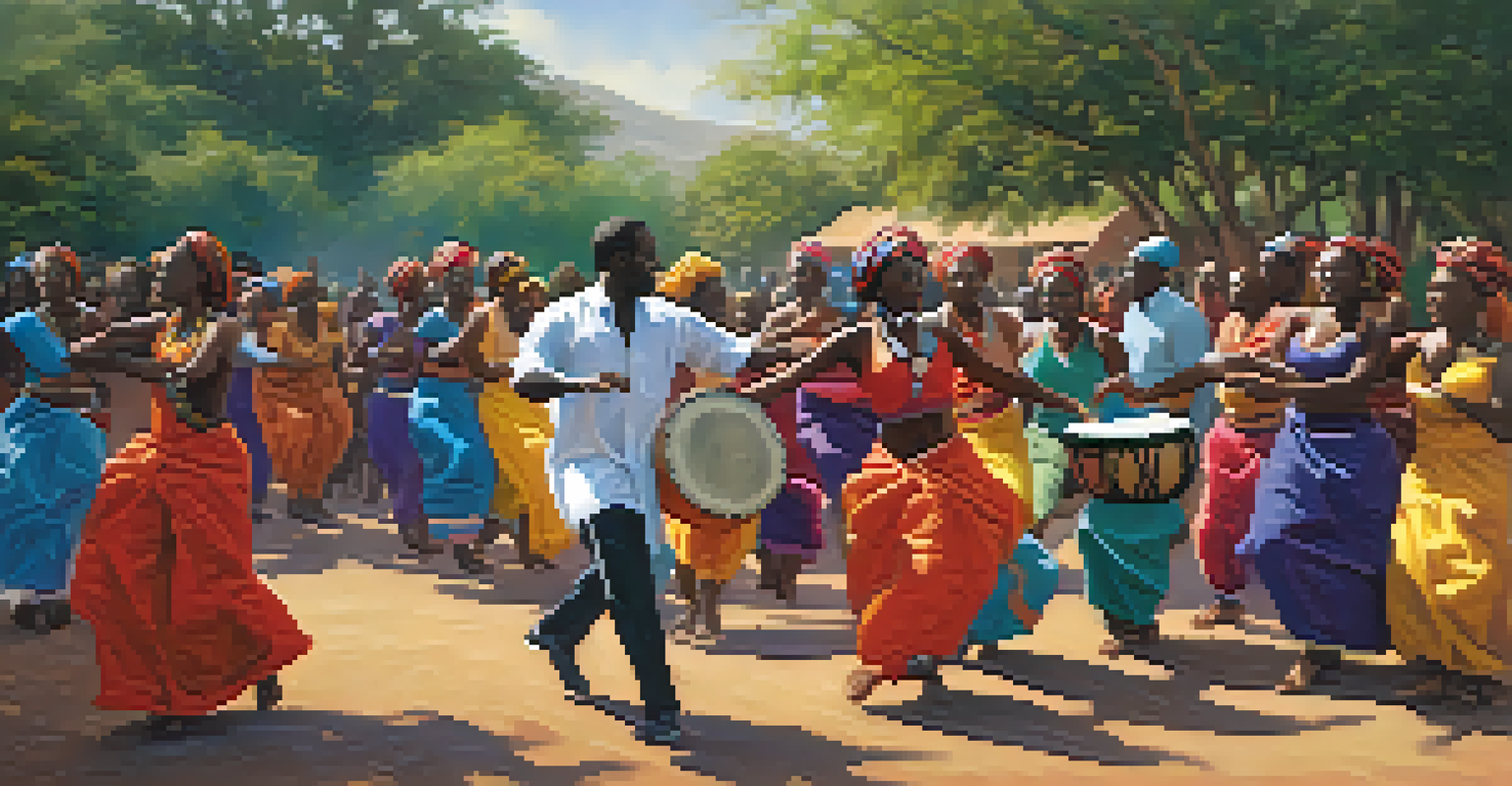The Role of Music in Spiritual Rituals Across Different Cultures

Understanding the Spiritual Power of Music
Music has long been intertwined with spirituality, serving as a universal language that transcends cultural barriers. It evokes emotions, fosters connection, and enhances the overall experience of spiritual rituals. Whether it's the soothing sound of a harp or the rhythmic beat of drums, music creates an atmosphere conducive to reflection and transcendence.
Music can change the world because it can change people.
In many cultures, music is believed to facilitate communication with the divine. For instance, Indigenous tribes often use traditional songs to invoke spirits and seek guidance during rituals. This powerful connection illustrates how music not only enriches the experience but also deepens the spiritual significance of the practice.
Moreover, the ability of music to induce altered states of consciousness further amplifies its role in rituals. Participants often describe feeling transported, as if the music has opened a portal to another realm, making their spiritual experience more profound and memorable.
African Traditions: Drumming and Dance
In many African cultures, drumming and dance are essential components of spiritual rituals. The rhythmic beats of drums not only energize participants but also sync them with the pulse of the earth and their ancestors. This connection is vital, as it fosters a sense of community and shared purpose during ceremonies.

For example, the Djembe drum, originating from West Africa, is often used in rituals to summon spirits and celebrate life events. The rhythmic patterns played on the Djembe can evoke strong emotions, drawing participants into a collective trance-like state that enhances their spiritual journey.
Music Bridges Spiritual Connections
Music transcends cultural barriers, enhancing spiritual rituals by evoking emotions and fostering connections.
Dance often accompanies these drumbeats, allowing individuals to express their spirituality physically. This synergy of music and movement serves to deepen the participants' emotional and spiritual connection, creating a holistic experience that resonates on multiple levels.
Sacred Chants in Eastern Spiritual Practices
In Eastern spiritual traditions, chanting holds a significant place in rituals, often used as a means of meditation and connection to the divine. Mantras, or sacred sounds, are repeated to help practitioners focus their minds and invoke specific energies. The sound of the mantra is believed to resonate with the universe, aligning inner and outer worlds.
Where words fail, music speaks.
For example, in Hinduism, the chant 'Om' is considered the sound of the universe and is often recited to elevate spiritual consciousness. This simple yet profound sound acts as a doorway to deeper meditation, allowing practitioners to experience a heightened state of awareness.
Similarly, in Tibetan Buddhism, chanting can be part of elaborate rituals that include the recitation of prayers and sutras. The melodic quality of these chants not only aids in concentration but also fosters a sense of peace and harmony within the community, enhancing the collective spiritual experience.
The Role of Gospel Music in Christian Worship
In Christian communities, gospel music plays a pivotal role in worship and spiritual expression. It uplifts congregants, encouraging them to engage both emotionally and spiritually during services. The powerful lyrics often convey messages of hope, love, and redemption, resonating deeply with believers.
During worship, gospel choirs harness the power of music to unite the congregation, creating an atmosphere of joy and reverence. The communal singing fosters a sense of belonging and shared faith, allowing individuals to feel connected to something greater than themselves.
Rhythms Unite in African Traditions
In African cultures, drumming and dance synchronize participants with their ancestors, creating a communal spiritual experience.
Additionally, gospel music often includes call-and-response elements, which invite participation and make the worship experience interactive. This dynamic exchange between leaders and the congregation enhances the spiritual atmosphere, making it a memorable experience for all involved.
Shamanic Practices: Music in Healing Rituals
In shamanic traditions, music serves as a vital tool for healing and spiritual journeys. Shamans use instruments like flutes, drums, and rattles to create soundscapes that guide individuals through altered states of consciousness. These musical elements help to facilitate connections with spirit guides and ancestors during healing rituals.
For example, the rhythmic drumming often used in shamanic ceremonies can induce trance states, allowing participants to explore their inner worlds and address emotional or physical ailments. The heartbeat-like rhythm helps to ground individuals while they navigate potentially challenging experiences.
Moreover, the use of specific melodies and harmonies can enhance the healing process, creating a nurturing environment where participants feel safe to explore their spirituality. This interplay of music and healing showcases the profound impact that sound can have on our emotional and spiritual well-being.
Indigenous Ceremonies: Songs of the Land
Many Indigenous cultures across the globe incorporate music deeply into their spiritual rituals, often using songs that reflect their connection to the land. These songs not only tell stories of creation and ancestry but also serve as a reminder of the sacred relationship between people and nature. Through music, they honor the spirits of the land and acknowledge their role as stewards of the earth.
For instance, in Native American traditions, songs are often sung during ceremonies to invoke the presence of spirits and ancestors. These songs may be accompanied by traditional instruments like flutes or drums, creating a rich tapestry of sound that enhances the spiritual experience.
Chanting Enhances Eastern Practices
In Eastern traditions, chanting sacred mantras helps practitioners focus and connect with the divine, elevating their spiritual consciousness.
The act of singing these songs reinforces community bonds, allowing participants to collectively express gratitude and reverence for their heritage. This shared musical experience fosters a sense of unity and belonging, illustrating the powerful role music plays in Indigenous spiritual practices.
Modern Spiritual Movements: Eclectic Musical Influences
In contemporary spiritual movements, music has taken on a more eclectic form, blending various genres and styles to create unique spiritual experiences. From New Age music to reggae-infused spiritual gatherings, these modern practices often reflect the diverse backgrounds of participants. This fusion allows for a more inclusive expression of spirituality.
For example, yoga classes often incorporate soothing instrumental music or chants, creating a tranquil environment for practitioners to connect with themselves. The use of sound baths and healing frequencies has also gained popularity in spiritual circles, illustrating how music continues to evolve in modern contexts.

These eclectic musical influences serve to enhance the spiritual journey, providing participants with a sense of freedom and creativity in their practices. Ultimately, this openness to diverse musical forms enriches the spiritual landscape, allowing for personal expression and connection.